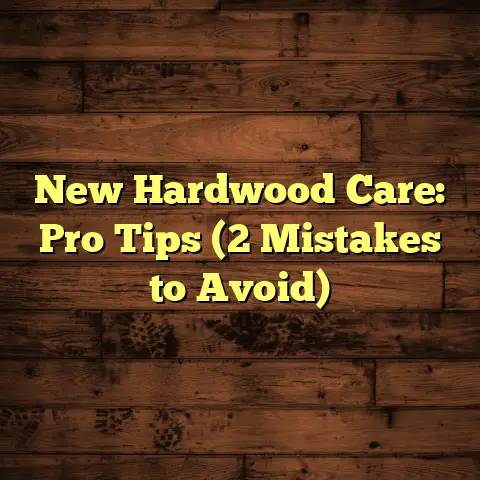Fill Wood Floor Gaps: What To Use? (1 Pro Tip!)
I’m Mike, a flooring contractor with over 20 years of experience, and I’ve seen it all when it comes to wood floors.
I’ve helped countless homeowners transform their living spaces.
Let me tell you, there’s nothing quite like the feeling of stepping onto a beautifully restored wood floor.
But, during these renovations, I often encounter a common issue: those pesky gaps between the boards.
I remember one client, Sarah, who was so excited to renovate her 1920s craftsman home.
She envisioned gleaming hardwood floors that would be the centerpiece of her design.
But then we discovered the gaps – wide enough to
lose a dime in!
Her excitement quickly turned into
frustration.
“Mike, what are we going to do?” she asked, her voice filled with concern.
That’s when I knew I had to help her find the perfect solution.
And that’s what I want to do for you today.
Filling those wood floor gaps isn’t just about aesthetics.
It’s about protecting your investment, improving your home’s energy efficiency, and creating a healthier living environment.
In this article, I’m going to walk you through everything you need to know about filling wood floor gaps.
I’ll cover the different materials you can use, the preparation process, the application techniques, and even a pro tip that will save you time and effort.
So, grab a cup of coffee, settle in, and let’s get started!
Section 1: Understanding Wood Floor Gaps
Alright, let’s start with the basics: What exactly are wood floor gaps, and why do they appear?
Wood floor gaps are those spaces that develop between the individual planks of your wood flooring.
They can range from hairline cracks to wide, noticeable separations.
So, why do these gaps happen?
Well, wood is a natural material, and it expands and contracts in response to changes in humidity and temperature.
Think of it like a sponge – it soaks up moisture in humid conditions and swells, and it releases moisture in dry conditions and shrinks.
This seasonal movement is the primary culprit behind wood floor gaps.
During the winter months, when the air is drier (especially if you’re running your heating system), the wood loses moisture and shrinks, creating gaps.
In the summer, when the air is more humid, the wood absorbs moisture and expands, closing those gaps.
This natural settling of your house also contributes to gaps.
Over time, the foundation can shift slightly, causing the wood floors to move and create separations.
Now, you might be thinking, “Okay, gaps are normal. So what?”
Well, leaving those gaps unaddressed can lead to a few problems.
First, they can become magnets for dust, dirt, and debris.
I’ve seen some pretty nasty stuff accumulate in those gaps over the years!
This not only makes your floors look dirty, but it can also trigger allergies and other health issues.
Second, gaps can affect your home’s energy efficiency.
Those small openings can allow drafts to enter, making your heating and cooling systems work harder to maintain a comfortable temperature.
According to the U.S.
Department of Energy,
drafts can increase your energy consumption by as
much as 20%!
And finally, let’s not forget about the aesthetic aspect.
Gaps can detract from the overall beauty of your wood floors, making them look old and worn.
I’ve seen homeowners spend thousands of dollars on renovations, only to have their floors ruined by unsightly gaps.
So, how common is this issue?
Well, it depends on several factors, including your climate, the type of wood flooring you have, and the age of your home.
In areas with extreme seasonal changes, like the Midwest or the Northeast, gaps are more prevalent.
According to a survey conducted by the National Wood Flooring Association (NWFA), approximately 70% of homeowners with wood floors experience some degree of gapping.
So, if you’re dealing with wood floor gaps, you’re definitely not alone!
Section 2: Materials for Filling Wood Floor Gaps
Alright, now that we understand why wood floor gaps occur and why it’s important to address them, let’s dive into the materials you can use to fill them.
There are several options available, each with its own pros and cons.
I’ll walk you through the most common ones and share my insights based on my experience.
Subsection 2.1: Wood Fillers
Wood fillers are probably the most popular choice for filling wood floor gaps, and for good reason.
They’re specifically designed to blend in with wood and create a seamless repair.
There are three main types of wood fillers:
-
Latex-Based Wood Fillers:
These are water-based fillers that are easy to apply and clean up.
They’re also relatively inexpensive and come in a variety of colors to match different wood species.
Pros:
- Easy to apply and clean up with water.
- Low odor and VOC (volatile organic compounds)
- Sandable and stainable.
- Good for small to medium-sized gaps.
Cons:
- Can shrink as they dry, requiring multiple applications.
- Not as durable as other types of fillers.
- May not be suitable for large gaps or high-traffic areas.
-
Epoxy Wood Fillers:
Epoxy fillers are two-part systems that consist of a resin and a hardener.
When mixed together, they create a very strong and durable filler that’s resistant to shrinking and cracking.
Pros:
- Extremely durable and resistant to shrinking and cracking.
- Good for large gaps and high-traffic areas.
- Can be used to repair damaged wood.
- Waterproof and resistant to chemicals.
Cons:
- More expensive than latex-based fillers.
- Can be difficult to mix and apply.
- May require special tools and techniques.
- Can have a strong odor.
-
Polyurethane Wood Fillers:
Polyurethane fillers are similar to epoxy fillers in that they’re very durable and resistant to shrinking and cracking.
However, they’re more flexible than epoxy fillers, which makes them a good choice for floors that experience a lot of movement.
Pros:
- Durable and flexible.
- Good for floors that experience movement.
- Resistant to shrinking and cracking.
- Can be sanded and stained.
Cons:
- More expensive than latex-based fillers.
- Can be difficult to apply smoothly.
- May require special tools and techniques.
When choosing a wood filler, it’s important to consider the size of the gaps you’re filling, the type of wood flooring you have, and the amount of traffic the area receives.
For small to medium-sized gaps in low-traffic areas, a latex-based filler may be sufficient.
For larger gaps or high-traffic areas, an epoxy or polyurethane filler is a better choice.
Also, be sure to choose a filler that’s compatible with the type of wood flooring you have.
Some fillers may not adhere well to certain types of wood, or they may react with the finish.
Subsection 2.2: Caulk
Caulk is another option for filling wood floor gaps, especially smaller ones.
It’s a flexible sealant that’s commonly used to fill gaps around windows, doors, and other fixtures.
Pros:
- Easy to apply with a caulking gun.
- Flexible and can accommodate movement.
- Waterproof and resistant to mold and mildew.
- Inexpensive and readily available.
Cons:
- Not as durable as wood fillers.
- Can shrink and crack over time.
- May not be stainable or paintable.
- Can look unnatural if not applied carefully.
Caulk is best suited for filling small gaps (less than 1/8 inch wide) in areas that don’t experience a lot of traffic.
It’s also a good choice for filling gaps around the perimeter of the room, where the floor meets the wall.
When using caulk, be sure to choose a type that’s specifically designed for wood floors.
Acrylic latex caulk is a good option because it’s paintable and can be tinted to match the color of your flooring.
Subsection 2.3: Wood Strips or Shims
For larger gaps (greater than 1/4 inch wide), wood strips or shims may be the best solution.
This involves inserting thin pieces of wood into the gaps to fill them.
Pros:
- Provides a natural and durable repair.
- Can be used to fill large gaps.
- Can be sanded and finished to match the existing flooring.
Cons:
- Requires more skill and effort to install.
- Can be time-consuming.
- May require special tools.
- Can be difficult to find wood that matches the existing flooring perfectly.
When using wood strips or shims, it’s important to choose a type of wood that’s similar to your existing flooring.
You’ll also need to make sure the strips are the right thickness to fit snugly into the gaps.
The installation process involves cutting the strips to the correct length, applying wood glue to the edges, and then tapping them into place with a hammer and a wood block.
Once the glue has dried, you can sand the strips flush with the surrounding flooring and then finish them to match.
Subsection 2.4: DIY Solutions vs. Professional Help
Now that we’ve covered the different materials you can use to fill wood floor gaps, let’s talk about whether you should tackle this project yourself or hire a professional.
There are pros and cons to both approaches.
DIY Methods:
Pros:
- Can save money on labor costs.
- Allows you to learn new skills.
- Can be a satisfying and rewarding experience.
Cons:
- Can be time-consuming and labor-intensive.
- May require special tools and equipment.
- Can be difficult to achieve professional-looking results.
- Risk of making mistakes that could damage your flooring.
Hiring Professionals:
Pros:
- Ensures high-quality workmanship.
- Saves you time and effort.
- Reduces the risk of mistakes.
- Can provide expert advice and guidance.
Cons:
- Can be more expensive than DIY methods.
- Requires you to find a reputable and qualified contractor.
- May involve scheduling and coordination challenges.
So, when should you consider DIY vs. hiring a pro?
Well, if you’re dealing with small gaps and you’re comfortable with basic woodworking skills, then filling the gaps yourself may be a good option.
However, if you’re dealing with large gaps, damaged wood, or a complex flooring system, then it’s best to hire a professional.
Also, if you’re not confident in your ability to achieve professional-looking results, then it’s always better to err on the side of caution and seek expert help.
I’ve seen too many homeowners try to save money by doing it themselves, only to end up making the problem worse and costing themselves more in the long run.
Section 3: Preparation and Application Process
Okay, let’s say you’ve decided to tackle this project yourself.
Before you start filling those gaps, it’s important to prepare the floor properly.
This will ensure that the filler adheres properly and that you achieve a smooth, long-lasting repair.
Here’s a step-by-step guide to the preparation and application process:
-
Clean the Gaps Thoroughly:
Use a vacuum cleaner with a crevice tool to remove any dust, dirt, or debris from the gaps.
You can also use a stiff brush or a putty knife to scrape out any stubborn particles.
For greasy or oily residue, use a mild detergent and water to clean the gaps.
Make sure the gaps are completely dry before proceeding to the next step.
-
Assess the Size and Depth of the Gaps:
Use a ruler or a measuring tape to determine the width and depth of the gaps.
This will help you choose the right type of filler and determine how much filler you’ll need.
Also, check for any loose or damaged wood around the gaps.
If you find any, you may need to repair or replace it before filling the gaps.
-
Choose the Right Filler Based on the Size and Type of Wood:
As we discussed earlier, different types of fillers are better suited for different types of gaps and wood.
For small gaps, a latex-based filler or caulk may be sufficient.
For larger gaps, an epoxy or polyurethane filler is a better choice.
For gaps in exotic or rare wood species, you may need to use a custom-tinted filler to match the color of the wood.
-
Gather Your Tools:
Here’s a list of the tools you’ll need for this project:
- Putty knife or trowel
- Caulking gun (if using caulk)
- Sandpaper (various grits)
- Wood block or tapping block
- Hammer
- Vacuum cleaner
- Measuring tape
- Painter’s tape
- Safety glasses
- Gloves
-
Apply the Filler:
-
If using a latex-based filler, apply it directly to the gaps with a putty knife or trowel.
Press the filler firmly into the gaps, making sure to fill them completely.
Remove any excess filler with a clean, damp cloth.
-
If using an epoxy or polyurethane filler, follow the manufacturer’s instructions for mixing and application.
These fillers typically require you to mix two parts together before applying them to the gaps.
Use a putty knife or trowel to apply the filler, making sure to fill the gaps completely.
Remove any excess filler with a clean, dry cloth.
-
If using caulk, load the caulk into a caulking gun and apply it to the gaps in a smooth, continuous bead.
Use your finger or a caulk smoothing tool to smooth out the caulk and remove any excess.
-
If using wood strips or shims, apply wood glue to the edges of the strips and then tap them into place with a hammer and a wood block.
Make sure the strips are flush with the surrounding flooring.
Remove any excess glue with a damp cloth.
-
-
Allow the Filler to Dry:
Follow the manufacturer’s instructions for drying times.
Latex-based fillers typically dry within a few hours, while epoxy and polyurethane fillers may take 24 hours or more to dry completely.
Avoid walking on the filled areas until the filler is completely dry.
-
Sand the Filled Areas:
Once the filler is dry, use sandpaper to sand the filled areas smooth.
Start with a coarse grit sandpaper (80-100 grit) to remove any excess filler and then switch to a finer grit sandpaper (120-150 grit) to smooth out the surface.
Be careful not to sand too much, as this could damage the surrounding flooring.
-
Stain or Finish the Filled Areas:
If necessary, stain or finish the filled areas to match the color of your existing flooring.
Use a stain or finish that’s compatible with the type of filler you used.
Apply the stain or finish according to the manufacturer’s instructions.
-
Clean Up:
Vacuum up any dust or debris from the sanding process.
Clean your tools with soap and water or a solvent, depending on the type of filler you used.
Section 4: Maintenance After Filling Gaps
Congratulations!
You’ve successfully filled those wood floor gaps.
But your work isn’t done yet.
To prevent future gaps from forming, it’s important to maintain your wood floors properly.
Here are a few tips:
-
Climate Control:
As we discussed earlier, changes in humidity and temperature are the primary causes of wood floor gaps.
To minimize wood movement, try to maintain a consistent humidity level in your home.
During the winter months, use a humidifier to add moisture to the air.
During the summer months, use a dehumidifier to remove excess moisture from the air.
The ideal humidity level for wood floors is between 30% and 50%.
-
Regular Cleaning:
Regularly sweep or vacuum your wood floors to remove dust, dirt, and debris.
This will prevent these particles from accumulating in the gaps and causing them to widen.
Avoid using harsh chemicals or abrasive cleaners, as these can damage the finish on your floors.
Instead, use a mild soap and water solution or a wood floor cleaner that’s specifically designed for your type of flooring.
-
Periodic Inspections:
Periodically inspect your wood floors for any new gaps or signs of damage.
Catching these problems early can prevent them from becoming bigger and more expensive to fix.
If you notice any new gaps, fill them as soon as possible using the methods we discussed earlier.
-
Avoid Excessive Moisture:
Avoid exposing your wood floors to excessive moisture.
Wipe up any spills immediately and avoid using wet mops or steam cleaners.
Also, make sure your appliances, such as dishwashers and washing machines, are properly sealed to prevent leaks.
-
Use Rugs and Mats:
Place rugs and mats in high-traffic areas, such as entryways and hallways, to protect your wood floors from wear and tear.
Also, use mats under furniture legs to prevent scratches and dents.
Section 5: The Pro Tip
Alright, it’s time for the pro tip that I promised you at the beginning of this article.
I’ve used this trick for years, and it’s saved me a ton of time and effort.
So, what is it?
The pro tip is to use rope to fill large or irregular gaps in your wood floors.
Yes, you read that right – rope!
Here’s how it works:
-
Find a natural fiber rope (like jute or cotton) that’s slightly thicker than the width of the gap.
-
Soak the rope in wood glue until it’s completely saturated.
-
Stuff the glue-soaked rope into the gap, using a putty knife or a screwdriver to push it in tightly.
-
Wipe away any excess glue with a damp cloth.
-
Let the glue dry completely.
-
Once the glue is dry, trim the rope flush with the floor using a utility knife.
-
Sand the filled area smooth.
-
Stain or finish the filled area to match the color of your existing flooring.
Why does this work so well?
Well, the rope provides a flexible and durable filler that can accommodate movement in the floor.
It also conforms to the shape of the gap, even if it’s irregular or uneven.
And because the rope is soaked in wood glue, it creates a strong bond with the surrounding wood.
I’ve used this technique to fill gaps in everything from antique floors to rustic cabins, and it’s never failed me.
So, the next time you’re dealing with large or irregular gaps in your wood floors, give this pro tip a try.
I guarantee you’ll be amazed at the results!
Conclusion
So, there you have it – everything you need to know about filling wood floor gaps.
I hope this article has been helpful and informative.
Remember, addressing those gaps isn’t just about aesthetics.
It’s about protecting your investment, improving your home’s energy efficiency, and creating a healthier living environment.
I know that home renovation can be an emotional rollercoaster.
I’ve seen homeowners go from excitement to frustration and back again.
But trust me, there’s nothing quite like the feeling of stepping onto a beautifully restored wood floor.
It’s a feeling of pride, accomplishment, and satisfaction.
So, whether you decide to tackle this project yourself or hire a professional, I encourage you to take action.
Don’t let those gaps detract from the beauty and value of your home.
With a little bit of effort and the right materials, you can keep your wood floors in pristine condition for years to come.
And who knows, maybe you’ll even discover a new passion for woodworking along the way!





